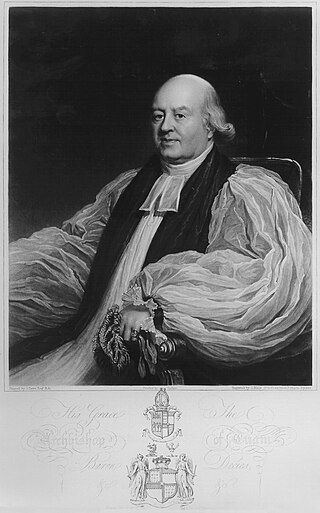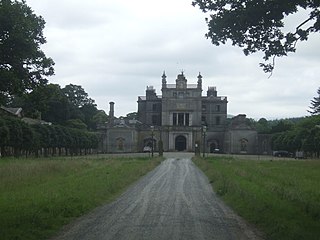
Marquess of Aberdeen and Temair, in the County of Aberdeen, in the County of Meath and in the County of Argyll, is a title in the Peerage of the United Kingdom. It was created on 4 January 1916 for John Hamilton-Gordon, 7th Earl of Aberdeen.
The Peerage of Ireland consists of those titles of nobility created by the English monarchs in their capacity as Lord or King of Ireland, or later by monarchs of the United Kingdom of Great Britain and Ireland. It is one of the five divisions of Peerages in the United Kingdom. The creation of such titles came to an end in the 19th century. The ranks of the Irish peerage are duke, marquess, earl, viscount and baron. As of 2016, there were 135 titles in the Peerage of Ireland extant: two dukedoms, ten marquessates, 43 earldoms, 28 viscountcies, and 52 baronies. However, these titles have no official recognition in the Republic of Ireland, with Article 40.2 of the Constitution of Ireland forbidding the state conferring titles of nobility and stating that an Irish citizen may not accept titles of nobility or honour except with the prior approval of the Irish government.

Admiral Charles William de la Poer Beresford, 1st Baron Beresford,, styled Lord Charles Beresford between 1859 and 1916, was a British admiral and Member of Parliament.

Marquess of Waterford is a title in the Peerage of Ireland and the premier marquessate in that peerage. It was created in 1789 for the Anglo-Irish politician George Beresford, 2nd Earl of Tyrone. The title is presently held by Henry Beresford, 9th Marquess of Waterford.

Marquess of Londonderry, of the County of Londonderry, is a title in the Peerage of Ireland.

Marquess Conyngham, of the County of Donegal, is a title in the Peerage of Ireland. It was created in 1816 for Henry Conyngham, 1st Earl Conyngham. He was the great-nephew of another Henry Conyngham, 1st Earl Conyngham, a member of a family of Scottish descent which had settled during the Plantation of Ulster in County Donegal in Ireland in the early 17th century. The 'founder' of the dynasty in Ireland was The Very Rev. Dr. Alexander Cunningham, Dean of Raphoe. The earlier Henry was a member of both the Irish House of Commons and the British House of Commons and served as Vice-Admiral of Ulster and as Governor of the counties of Donegal and Londonderry. In 1753 he was raised to the Peerage of Ireland as Baron Conyngham, of Mount Charles in the County of Donegal, and in 1756 he was created Viscount Conyngham, in Ireland, also in the Peerage of Ireland. In 1781 he was made Baron Conyngham, of Mount Charles in the County of Donegal, with remainder to his nephew Francis Burton, and Earl Conyngham, of Mount Charles in the County of Donegal, which like the creations of 1753 and 1756 was created with normal remainder to the heirs male of his body. The latter titles were also in the Peerage of Ireland. Lord Conyngham was childless and on his death in 1781 the barony of 1753, the viscountcy and earldom became extinct while he was succeeded in the barony of 1781 according to the special remainder by his aforementioned nephew Francis. He was the eldest son of Mary, sister of the first Earl Conyngham, by her husband Francis Burton. The new 2nd Baron Conyngham, who had earlier represented Killybegs and County Clare in the Irish House of Commons, assumed by Royal licence the surname and arms of Conyngham on succeeding to the titles.

Marquess of Linlithgow, in the County of Linlithgow or West Lothian, is a title in the Peerage of the United Kingdom. It was created on 23 October 1902 for John Hope, 7th Earl of Hopetoun. The current holder of the title is Adrian Hope.

Earl Howe is a title that has been created twice in British history, for members of the Howe and Curzon-Howe family respectively. The first creation, in the Peerage of Great Britain, was in 1788 for Richard Howe, 4th Viscount Howe, but it became extinct upon his death in 1799. The second creation, in the Peerage of the United Kingdom, was in 1821 for Richard Curzon-Howe, 2nd Viscount Curzon, and it remains extant.

Baron Decies, of Decies in the County of Waterford, is a title in the Peerage of Ireland. It was created in 1812 for the Right Reverend William Beresford, Archbishop of Tuam from 1794 to 1819. He was the third son of Marcus Beresford, 1st Earl of Tyrone, and the younger brother of George Beresford, 1st Marquess of Waterford. His son, the second Baron, married Charlotta Philadelphia Horsley, the only daughter and heiress of Robert Horsley (1749-1809) of Bolam Hall in Northumberland, which he built on the estate purchased in 1727 by his father John Horsley. In accordance with the terms of his wife's inheritance he assumed the additional surname of Horsley in 1810. However, none of the subsequent barons have held this surname. His grandson, the fifth Baron, was a Major in the Army and also sat in the House of Lords as an Irish representative peer from 1912 to 1944. As of 2013 the title is held by his grandson, the seventh Baron, who succeeded his father in 1992.

Baron Feversham is a title that has been created twice, once in the Peerage of Great Britain and once in the Peerage of the United Kingdom. The first creation, in the Peerage of Great Britain, came in 1747 when Anthony Duncombe, who had earlier represented Salisbury and Downton in the House of Commons, was made Lord Feversham, Baron of Downton, in the County of Wilts. He had previously inherited half of the enormous fortune of his uncle Sir Charles Duncombe. However, Lord Feversham had no sons and the barony became extinct on his death in 1763. The peerage was revived in the Peerage of the United Kingdom in 1826 in favour of his kinsman Charles Duncombe, who was created Baron Feversham, of Duncombe Park in the County of York. He was a former Member of Parliament for Shaftesbury, Aldborough, Heytesbury and Newport. Duncombe was the grandson of Thomas Duncombe, son of John Brown by his wife Ursula Duncombe, aunt of the first Baron of the 1747 creation. Ursula had inherited the other half of her brother Sir Charles Duncombe's fortune. Lord Feversham son, the second Baron, sat as a Conservative Member of Parliament for Yorkshire and the North Riding of Yorkshire.

Earl of Clanricarde is a title that has been created twice in the Peerage of Ireland, first in 1543 and again in 1800. The former creation became extinct in 1916 while the 1800 creation is extant and held by the Marquess of Sligo since 1916.

John Henry de la Poer Beresford, 5th Marquess of Waterford,, styled Earl of Tyrone from 1859 to 1866, was an Irish peer and Conservative politician. He served as Master of the Buckhounds under Lord Salisbury from 1885 to 1886.

George de la Poer Beresford, 1st Marquess of Waterford, KP, PC (Ire), styled Earl of Tyrone from 1763 to 1789, was an Anglo-Irish politician.
William Annesley, 1st Viscount Glerawly was an Irish politician and noble.

William Beresford, 1st Baron Decies was an Anglo-Irish clergyman.
Baron La Poer, de la Poer, is a title in the Peerage of Ireland held by the Marquess of Waterford. Its creation is the sole instance in the law of the Kingdom of Ireland recognising a peerage by writ.
Henry de la Poer Beresford, 2nd Marquess of Waterford, KP, PC (Ire) styled Lord Le Poer from 1783 until 1789 and Earl of Tyrone from 1789 to 1800, was an Irish peer.

Marcus Beresford, 1st Earl of Tyrone, known as Sir Marcus Beresford, 4th Baronet, until 1720 and subsequently as The Viscount Tyrone until 1746, was an Anglo-Irish peer and politician.

Curraghmore near Portlaw, County Waterford, Ireland, is a historic house and estate and the seat of the Marquess of Waterford. The estate was part of the grant of land made to Sir Roger le Puher by Henry II in 1177 after the Anglo-Norman invasion of Ireland. Since then, the De La Poer Beresford family has owned these estates. It is the oldest family home in Ireland.
John Beresford, 2nd Baron Decies, later Horsley-Beresford, was an Anglo-Irish peer and clergyman.











